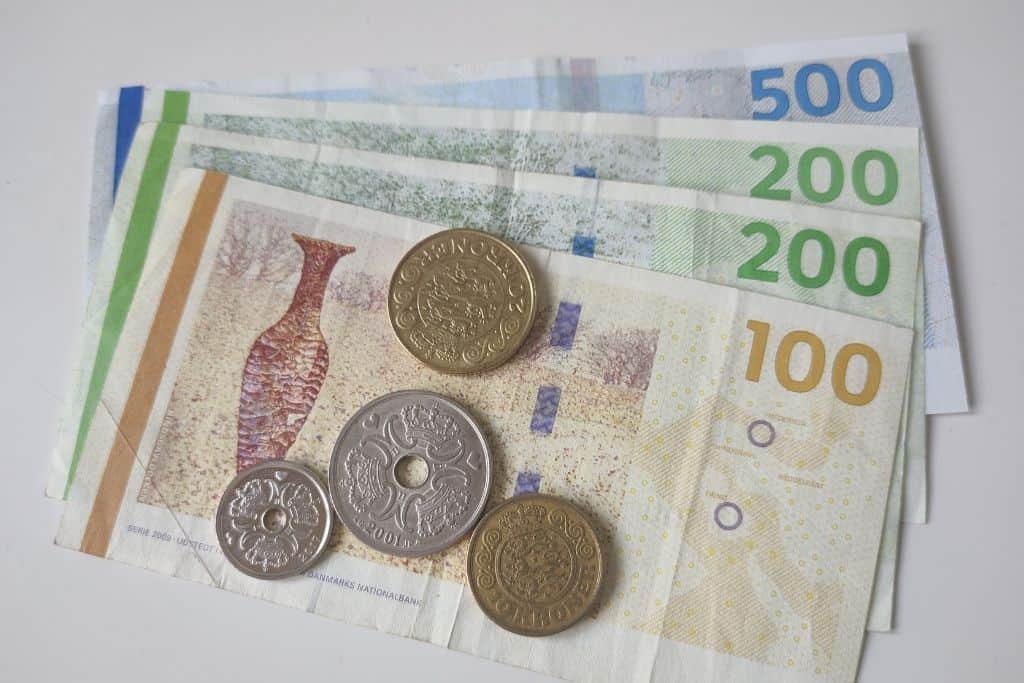The Best Way To Pay For Things During Your Trip To Denmark
Although Denmark isn’t cashless, the use of cash is decreasing. In Denmark, you can use your credit cards to pay for something as small as a packet of gum. And in Copenhagen, automated station toilets only accept cards, no cash!
However, the cash rule states that all shops have to accept cash between the hours of 6 am and 10 pm (except stores in high-risk areas when the cut-off time is 8 pm).
Credit cards and mobile banking apps are all accepted in Denmark, so you have little need for cash, especially in Copenhagen.
But if you intend to travel beyond Greater Copenhagen on your trip to Denmark, you will need a small amount of cash for things like local buses and toilets.
As a guide, a 2-zone local transport ticket in Copenhagen costs 24 kr, and a 3-zone ticket costs 30 kr.
Change is given when paying for local transport with cash, but you can only pay for your ticket with a banknote of up to 100 kr.
Use the DSB, DOT or Rejseplanen apps to plan your journey and buy your transport tickets in advance.

Disclosure: This website is owned and operated by My Path To Travel. As an Amazon Associate, I earn from qualifying purchases. I earn commissions for links to SHEMedia, Get Your Guide and other retailers. See My Path To Travel Disclaimer for more information.
How Do You Pay For Things In Denmark?
You can pay for goods and services in Denmark using the following –
- Mastercard
- Visa
- American Express
- Diners Club
- Mobile Pay
- Apple Pay
- Google Pay
- Samsung Pay
- Cash
Which Credit Cards Are Widely Accepted in Denmark?
Visa and Mastercard are the most widely accepted credit cards in Denmark.
American Express and Diners Club are accepted, although not everywhere, and they are not as commonly used as they once were. As a result, the retailer may charge you an additional fee for using these cards.
Essential Things To Know When Using Credit Cards in Denmark
Danish Restaurants can charge between 3% – 7% extra on the total bill when paying with a foreign credit or debit card.
Credit card transactions are contactless unless you spend over a specified amount, currently 350 kr. (All prices in my articles link to the Xe currency converter so you can check the prices in your currency.)
Always choose the local currency if given the option to pay in local or home currency. For example, if you have to decide between Danish kroner or US dollars, choose kroner. Paying in the local currency means your home bank will do the conversion, and it will be at a much better exchange rate than letting the vendor do the conversion.
Danish ATMs, point-of-sale terminals, credit card readers, etc., use four-digit PIN codes. If you have a six-digit PIN code or an old-style credit or debit card with a magnetic strip, you’ll need to request a new card from your card provider to use your card in a Danish ATM.
If you are unsure if your credit or debit card will work in Denmark, check with your bank before leaving home. Allow yourself plenty of time to request a new card if necessary.
Also, make sure to check the expiry date on your cards to ensure they won’t expire while you’re away.
What You Need To Know About Euronet ATM’s
Don’t Use Euronet ATMs
Euronet’s exchange rate is appalling. They charge a transaction fee and a terminal exchange fee, and of course, they add your own bank charges to the transaction. That’s three fees on top of the worst exchange rate out there!

Can I Use A Debit Card In Denmark?
If your debit card is linked to Mastercard or Visa, you can use your debit card in Denmark.
What Is The Currency Of Denmark
Denmark’s currency is the krone, which means crown in Danish. Kroner is the plural of krone.
The symbol for the Danish Krone is kr.
While Danish kroner is better to use, euros and dollars can be used when paying for high-priced items such as hotel rooms.
Danish krone bills are available in the following denominations: 500 kr (blue), 200 kr (green), 100 kr (brown) and 50 kr (purple). The 1,000 kr bill was removed from circulation in May 2025.
Danish coins still in use are 20 kr, 10 kr, 5 kr, 2 kr, 1 kr, 50 øre (½ kr). Use xe.com currency converter to check the denominations in your currency.
Are US Dollars Accepted in Copenhagen?
US dollars are accepted for larger purchases in the tourist areas of Copenhagen but don’t expect to get a decent exchange rate. Your change will be returned to you in Danish kroner, also at a disadvantageous exchange rate.

Can I Use Euros In Copenhagen?
You may be able to use euros in Copenhagen for large purchases in tourist areas, but the same as US dollars, you’ll get a poor exchange rate. And any change will be returned to you in kroner also at a low exchange rate.
What Is The Current Exchange Rate For Danish Kroner?
This table shows the Danish kroner exchange rate compared to the dollar, euro and pound as of July 2025. You can find the latest exchange rate at xe.com.
| Currency | Kroner kr | Dollar $ | Euro € | Pound £ |
|---|---|---|---|---|
| 10 kroner | – | $1.51 | €1.34 | £1.12 |
| 10 dollar | 66.1 kr | – | €9.12 | £7.75 |
| 10 euro | 74.7 kr | $10.9 | – | £8.33 |
| 10 pound | 88.5 kr | $12.9 | €11.9 | – |
Banking Hours In Denmark
As a general rule, banks in Denmark are open from 10 am to 4 pm Monday to Friday and closed at the weekend and on public holidays.
If you want to know more about public holidays in Denmark, check out this guide to what to expect on public holidays in Denmark. It’s filled with helpful info!
Denmark relies heavily on online banking, and very few banks now offer the opportunity to withdraw or deposit cash. With the exception of airport branches, Danish banks don’t offer foreign currency exchange facilities.
Where To Exchange Currency In Copenhagen
Any currency exchange (Bureau de Change) will sell you Danish kroner. You can also withdraw kroner from ATMs using international debit and credit cards.
There are three currency exchange stores inside Copenhagen Central Station (København H) and several more opposite the station on Vester Farimagsgade. There are also many more Bureau de Change dotted around the city centre.
Don’t be fooled by text stating there is no commission charged when exchanging money. The commission rate is ‘hidden’ inside the exchange rate and isn’t shown as a separate charge.
Use the table below to find your nearest currency exchange service.
| Bureau de Change | Location Details |
|---|---|
| Forex Bank | Find Forex |
| Ria | Find Ria |

500 Euro Bills Can Not Be Used Or Exchanged in Denmark
In 2020, legislation made it illegal to exchange or spend 500 Euro bills in Denmark. The law was introduced to combat money laundering. For more information, take a look at this article from Pymnts.com.
Similarly, the Danish 1,000 kr bill was removed from circulation in May 2025, to prevent money laundering.
Exchanging Money At Copenhagen Airport
Copenhagen Airport has four currency exchange offices after security and three before security. But just like any airport, the exchange rate is poor.
Danske Bank has one branch before and another after security at Copenhagen airport. Use the ATMs attached to the bank to withdraw money for a better exchange rate than either the currency exchange offices or Euronet ATMs.
How Much Will I Be Charged For Withdrawing Cash From An ATM In Denmark?
The charges laid out below are a guide. Your bank may also limit how much you can withdraw on your card and add additional fees.
| Bank | Maximum Withdrawal | ATM Charge Per Withdrawal |
|---|---|---|
| Danske Bank | 2,000 kr – 6,000 kr per working day | 50 kr |
| Jyske Bank | 5,000 kr per working day 2,000 kr between 6 pm and 9 am, weekends and public holidays | 15 kr – 50 kr |
| Nordea Bank | 2,000 kr per working day | 50 kr |
How To Keep Your Money Safe While Travelling in Denmark
While Denmark is a safe country to visit, you still need to take the usual precautions to keep your cash safe. These money belts, available from Amazon, are perfect. I’ve been using one for over 20 years and wouldn’t travel without it.
They aren’t bulky and hold a lot of cash and a paper copy of your passport if you fold it correctly. Moreover, it’s just as comfortable as any other belt; you won’t know you’re wearing it, and neither will anyone else!
Alternatively, the Flipbelt is designed to hold your money and have space for your phone and essential documents.
Check Out These Articles To Help You Save Money During Your Copenhagen Trip
Where To Find Your Closest ATM In Denmark
An ATM (Automated Teller Machine) is called Pengeautomat in Denmark. Penge is Danish for money.
Use the links below to find your closest ATM.
| Bank | ATM Finder |
|---|---|
| Danske Bank | Danske Bank ATM Locations |
| Nordea Bank | Nordea Bank ATM Locations |
| Jyske Bank | Jyske Bank ATM Locations |
Can I Use Travellers Cheques In Denmark?
For the most part, travellers’ cheques are no longer accepted at banks or currency exchanges in Denmark.
How Much Cash Can You Bring Into Denmark?
You must declare anything over 10,000 euros (approximately 75,000 Danish kr) when you enter or leave Denmark. That includes traveller’s cheques, cheques or gold.
When crossing the border, you must complete a customs declaration form and submit it to the customs agency.
Failure to declare money over 10,000 euros could result in a fine and or the seizure of cash and valuables.
Would You Like Help Planning Your Trip?
I’ve lived in Copenhagen for over a decade and have all the best insider tips and local know-how to ensure your trip is unforgettable. Got a question? My advice is free, so don’t hesitate to ask for help.
I also offer premium paid services if you’re looking for a more personalised touch or a detailed itinerary. Discover how, together, we can tailor your Copenhagen experience and make your trip truly memorable!
How To Save Money During Your Trip To Denmark
-
16 Free Museums in Copenhagen You Can’t Afford to Miss
Travelling on a budget and think Copenhagen is too expensive? Think again! The city has several world-class free museums that won’t cost you a single krone, if you know when and where to go. While all museums in Copenhagen are…
-
Discover All The Free Things To Do In Copenhagen
With a wide range of free things to do, Copenhagen can be an ideal destination for budget-conscious travellers who want to make the most of their trip without breaking the bank. Despite being one of the world’s top tourist cities,…
-
What Is The Copenhagen Card And Is It Worth Buying?
The Copenhagen Card is a popular option for exploring the city’s top attractions such as Tivoli Gardens, the National Museum and Rosenborg Castle while saving money on entry fees and transport. Designed to make sightseeing simple and stress-free, it’s especially…



